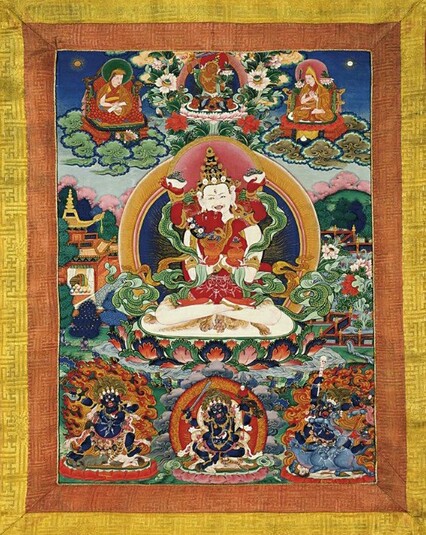
Item: Chakrasamvara (Buddhist Deity) - White (Umapa Tradition)
| Origin Location | Tibet |
|---|---|
| Date Range | 1800 - 1899 |
| Lineages | Gelug and Buddhist |
| Size | 106.68x66.04cm (42x26in) |
| Material | Ground Mineral Pigment on Cotton |
| Collection | Asian Art Museum of San Francisco |
| Catalogue # | B78D3 |
Classification: Deity
Appearance: Peaceful
Gender: Male
White Chakrasamvara: according to the tradition of Lama Umapa.
The White Chakrasamvara tradition of Lama Umapa describes the deity as having a single face and two arms, embracing a red consort. Both are in a seated posture. The male figure holds two long-life vases in the right and left hands folded around the back of the consort. The consort holds two skullcups in the right and left hands. She is seated with her legs wrapped around the waist of Chakrasamvara.
"...Chakrasamvara, white like the reflection of the sun on a crystal mountain, stainless and radiant, one face, two hands, three eyes, hair in a topknot, adorned with beautiful ornaments, holding two long-life vases in the hands, embracing the consort, seated in vajra posture. In the lap is Vajrayogini, red in color, with one face, two hands and three eyes, seated, holding a skullcup filled with nectar in each hand, embracing the Lord around the neck, the two legs embracing the waist, beautifully dressed."
[Lineage]: "Vajradhara, Manjushri, Pawo Dorje [Umapa], Tsongkapa [1357-1419], Jampel Gyatso, Kedrub Geleg Palzang, Baso Chokyi Gyaltsen, Chokyi Dorje, Lobzang Dondrub, Kedrub Sanggye Yeshe, Lobzang Chokyi Gyaltsen, Konchog Gyaltsen, Panchen Lobzang Yeshe, Lobzang Zopa, Lobzang Palden Yeshe, Lobzang Jampal, etc." (bde mchog dkar po'i tshe sgrub bdag mdun dang bcas pa, by rta tshag 08 bstan pa'i mgon po. Volume 2, folio 13-22. Gyaltsab Yeshe Lobzang Tanpa'i Gonpo, 1760-1810).
The description of White Chakrasamvara written by the 8th Tatsag is based on a sadhana written by the 5th Dalai Lama, Ngagwang Lobzang Gyatso (1617-1682).
At the top center is Orange Manjushri with a Tibetan teacher seated on the right and left sides. It is possible that the figure on the left is Lama Umapa and the figure seated on the right is Lama Tsongkapa.
At the bottom center is Chaturbhuja Mahakala with one face and four arms. At the left side is Inner Yama Dharmaraja. On the right side is Outer Yama Dharmaraja.
Jeff Watt & Karma Gellek 9-2012
Buddhist Deity: Chakrasamvara, White (Lama Umapa)
Buddhist Deity: Chakrasamvara Main Page
Collection of Asian Art Museum of San Francisco
Buddhist Deity: Chakrasamvara, White
